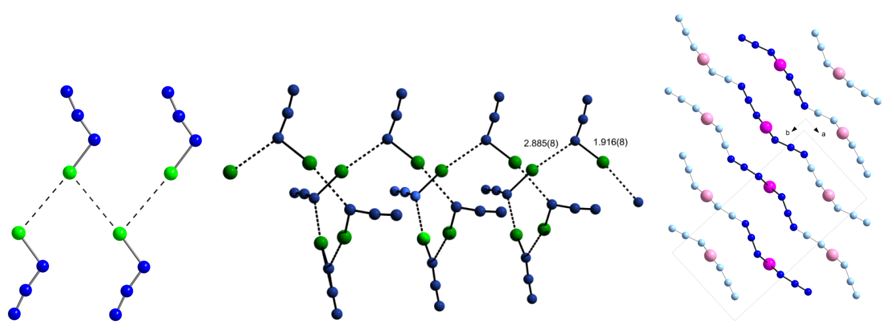Group 17 azides
1.2.2.3 Group 17 azides
Halogen azides XN3 (X = F, Cl, Br, I) are known for more than a century. Even though they have been investigated using NMR, IR, photoelectron, and microwave spectroscopy as well as electron diffraction, single crystal X-ray diffraction studies remained very rare. Only IN3, which adopts a polymeric chain-like structure in the solid state, has been structurally characterized.[1] We recently grew single crystals of ClN3, BrN3 and IN3 directly on the diffractometer by situ crystallization using a miniature zone melting procedure with focused infrared-laser-radiation and investigated their solid state structures.[2]
The Na-Nb and Nb-Ng bond lengths in all three halogen azides differ significantly, clearly proving the covalent-bonding character, while the Na-Nb-Ng (roughly 170°) and X-Na-Nb bond angles (almost 108°) are comparable. The Na-X bond increases with increasing atomic number of the halogen atom as was expected.
The major differences in the structures of ClN3, BrN3 and IN3 is reflected by different intermolecular interactions. ClN3 adopts a chain-like polymeric structure due to the formation of Cl···Cl interactions. This chain is comparable to the "herring bone" arrangement in the solid state structures of the elemental halogens X2, however the solid state structure of Cl2 shows additional Cl···Cl interactions at the "opposite end" of the molecule, which were not observed in the packing of ClN3.

Figure 2: Chain in the packing of ClN3 formed via 21 screw axis (-x, -y+2, z+1/2) (left), helical structure as observed for BrN3 due to intermolecular interactions between Na and the adjacent bromine atom (middle) and polymer chains in IN3; one stack of chains is highlighted; View parallel to c along the polymer chains (right).
BrN3 forms a helical structure in the solid state, an unforeseen structural motif in covalent azide chemistry, and shows not only Br···N contacts but also N···N contacts (3.094(16) Å). IN3 form one-dimensional polymeric structures in the solid state. The Nγ of both positions of the azide groups share the same site in both polymorphs as a structural consequence of the disorder.
References
[1] P. Buzek, T. M. Klapötke, P. v. R. Schleyer, I. C. Tornieporth-Oetting, P. S. White, Angew. Chem. Int Ed. 1993, 32, 275.
[2] a) B. Lyhs, D. Bläser, C. Wölper, S. Schulz, G. Jansen, Angew. Chem. Int. Ed. 2012, 51, 1970; b) B. Lyhs, D. Bläser, C. Wölper, S. Schulz, G. Jansen, Angew. Chem. Int. Ed. 2012, 51, 12859.
Go back: Group 15 azides

